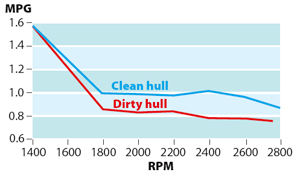A clean hull enables your boat to run as efficiently as possible but how much can you actually save? MBM finds out...
It is common sense that fouling on a boat’s hull will lead to increased resistance, which basically means you are going to burn more fuel for every knot you make. The outcome is compromised efficiency and a poorer mpg figure than with a clean hull, but by how much?
To answer this question we undertook some comprehensive seatrials in a 10-year-old Princess 430 installed with twin Volvo TAMD63P engines rated to 370hp at 2800rpm, measuring its performance before and after its spring lift, scrub and antifoul.

The performance table tells the full story but, in short, the boat’s increase in speed for the same revs averages out at around 13%, as well as an overall reduction in fuel consumption.
The result is that the all-important measure of efficiency – miles per gallon – jumps by around 25% with the cleaner hull. Even better, at the boat’s usual 2400rpm cruising rate the mpg figure is a massive 30% up.


With these figures in mind it makes good sense to try to grab a scrub before setting off on any prolonged cruise.
During a two-week, 600-mile round trip the owners of this Princess will save a couple of hundred quid with a clean hull, and it will make faster passages without pushing the engines harder than is necessary.










